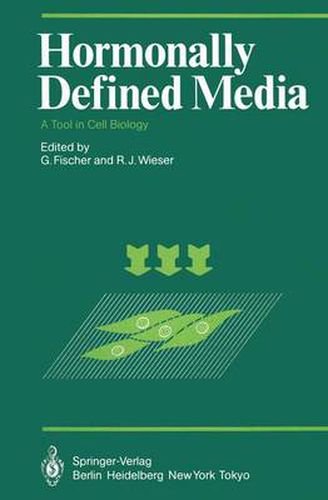Readings Newsletter
Become a Readings Member to make your shopping experience even easier.
Sign in or sign up for free!
You’re not far away from qualifying for FREE standard shipping within Australia
You’ve qualified for FREE standard shipping within Australia
The cart is loading…






This title is printed to order. This book may have been self-published. If so, we cannot guarantee the quality of the content. In the main most books will have gone through the editing process however some may not. We therefore suggest that you be aware of this before ordering this book. If in doubt check either the author or publisher’s details as we are unable to accept any returns unless they are faulty. Please contact us if you have any questions.
Until some years ago serum or crude tissue extracts were used pre dominantly or exclusively as media supplements for the cultivation of cells. However, during this time evidence accumulated that these sup plements could not provide in an optimal way most of the cultivated cells with all factors necessary for their survival, their prolifer ation and/or differentiation. Moreover, a variety of cells could not be cultivated at all under these conditions and often the composition of the cultures changed within rather short periods of time by overgrowth of initially present subpopulations of those cells which grow well in these supplements, as for example fibroblasts. Nevertheless, using these supplements (or fractions thereof), insight could be gained into some of the influences of serum or tissue extract constituents with re gard to survival, proliferation and differentiation of cells in cul ture. It became obvious from these experiments that serum or tissue extracts did not only supply cells with nutrients or vitamins (which are now constituents of all basic media), but also with hormones as well as growth-, differentiation-, and attachment-factors. In course of time experiments were performed in which serum enriched with hormones and other growth factors was used to successfully culti vate those cells which could not survive in serum-supplemented media alone. Under normal conditions in an organism, however, only a small population of cells has direct contact with serum.
$9.00 standard shipping within Australia
FREE standard shipping within Australia for orders over $100.00
Express & International shipping calculated at checkout
This title is printed to order. This book may have been self-published. If so, we cannot guarantee the quality of the content. In the main most books will have gone through the editing process however some may not. We therefore suggest that you be aware of this before ordering this book. If in doubt check either the author or publisher’s details as we are unable to accept any returns unless they are faulty. Please contact us if you have any questions.
Until some years ago serum or crude tissue extracts were used pre dominantly or exclusively as media supplements for the cultivation of cells. However, during this time evidence accumulated that these sup plements could not provide in an optimal way most of the cultivated cells with all factors necessary for their survival, their prolifer ation and/or differentiation. Moreover, a variety of cells could not be cultivated at all under these conditions and often the composition of the cultures changed within rather short periods of time by overgrowth of initially present subpopulations of those cells which grow well in these supplements, as for example fibroblasts. Nevertheless, using these supplements (or fractions thereof), insight could be gained into some of the influences of serum or tissue extract constituents with re gard to survival, proliferation and differentiation of cells in cul ture. It became obvious from these experiments that serum or tissue extracts did not only supply cells with nutrients or vitamins (which are now constituents of all basic media), but also with hormones as well as growth-, differentiation-, and attachment-factors. In course of time experiments were performed in which serum enriched with hormones and other growth factors was used to successfully culti vate those cells which could not survive in serum-supplemented media alone. Under normal conditions in an organism, however, only a small population of cells has direct contact with serum.